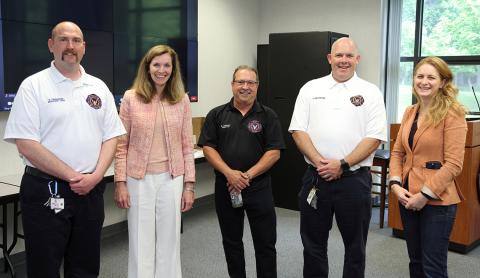Fabric of Community, Saving Lives
NIH Leaders Thank Campus Fire & Rescue

Photo: Chia-Chi Charlie Chang
One of the first groups NIH leadership planned to thank for their exceptional service during the Covid-19 pandemic was the Division of Fire and Rescue Services (DFRS). The stars finally aligned on May 19 to make that stop on the “gratitude tour” a reality.
“You all literally put your lives on the line every single time you come to work,” said Colleen McGowan, director, Office of Research Services, introducing the hybrid event that began in the NIH fire station’s classroom.
These last few years, DFRS not only maintained their regular operations, but they also put in extensive overtime throughout the pandemic.
“Covid impacted everything that everyone did,” said NIH Acting Principal Deputy Director Dr. Tara Schwetz. “I know you all performed specialty transports to the Clinical Center’s Special Clinical Studies Unit, which was critical to the work [doctors and staff] were doing with Covid-positive patients.”

Photo: Chia-Chi Charlie Chang
In addition, DFRS became incident commanders who managed operations for the car-line site that tested symptomatic employees. “We at NIH became a model and example of what could be done” to limit the spread of Covid-19 and keep staff healthy, said Schwetz.
“I don’t think people realize how much you are a fabric of the Montgomery County community,” said McGowan, noting the services provided by DFRS extend well beyond the NIH campus where the firehouse is located.
In 2022, DFRS responded to nearly 2,500 emergency incidents on the Bethesda campus and throughout the county and has already responded to more than 700 incidents so far this year.
“You risk your lives every day to save lives and we thank you for that,” said NIH Deputy Director for Management Dr. Alfred Johnson. He mentioned his daughter is a volunteer firefighter and paramedic. “When she’s on call, I don’t sleep so well so I can imagine [the challenges you and your families face] on a regular basis.”

Photo: Chia-Chi Charlie Chang
They respond at a moment’s notice to emergency calls—building fires, explosions, accidents. Recently, an NIH firefighter saved a person trapped underneath a Metro train. Some of them have been injured in the line of duty.
“This is the only group of people I know of that, as part of their [job] description, are running into buildings as other people are running out,” said Bill Cullen, NIH associate director for security and emergency response. He highlighted the extraordinary dedication of DFRS, which celebrates its 70th anniversary this year. At least 10 firefighters are always on call, sleeping in bunk rooms at the station; most are working 72 hours per week.

Photo: Chia-Chi Charlie Chang
“I know what it takes to go down a smoke-filled hallway…That’s tough work,” said DFRS Acting Director Mat Chibbaro. “I know it’s a significant risk decision to bring your crew into an unstable portion of a building after the other half just blew up.”
DFRS firefighters all undergo specific training in hazmat, given the potential exposure to chemicals, contagions and radiation at NIH, as well as emergency medical services.
Chibbaro said there’s also a soft skills element to their jobs, “whether it’s getting slimed at the Children’s Inn or changing a tire for the elderly.”
Beyond gratitude, the event provided firefighters the opportunity to ask candid questions and express their concerns and ideas to NIH leadership.
After the formal presentation, DFRS guided NIH leaders on a tour through the station where they visited memorabilia in the lobby; offices and the equipment room; the upstairs bunk rooms along a picture-filled hallway; the gym and the apparatus bay. They also proudly showed off an additional apparatus bay under construction, which will house upgraded equipment including a new ladder truck to add to their vehicle fleet.

Photo: Chia-Chi Charlie Chang
Morale keeps growing amid the upgrades, renovations and the addition of new staff. “As you continue to rebuild and regroup with renewed focus,” Johnson said, “we are looking forward to the [continued] tremendous contribution from you to the NIH community.”
Schwetz asked the firefighters why—when they could work anywhere—they chose to work at NIH.
Master Firefighter Thomas Dennison said he came based on NIH’s reputation.
“What brings me here is the promotion opportunities; the small tight-knit group that we have—we hang out with each other’s families on the weekends,” he said. “The training opportunities here are unlike any other federal installation. The funding is better. The apparatus is top notch and we’re getting upgrades…This is the place to be.”








